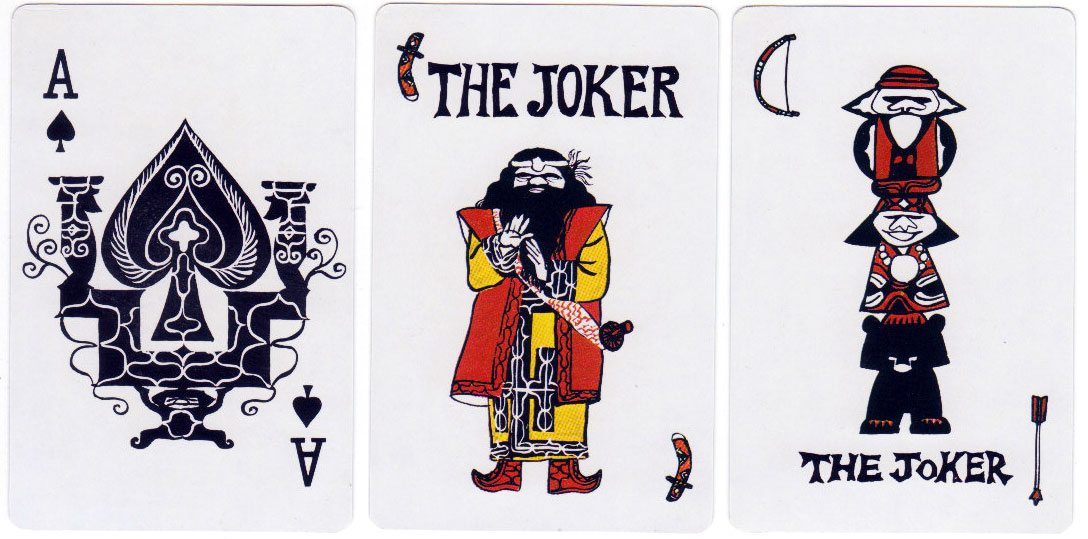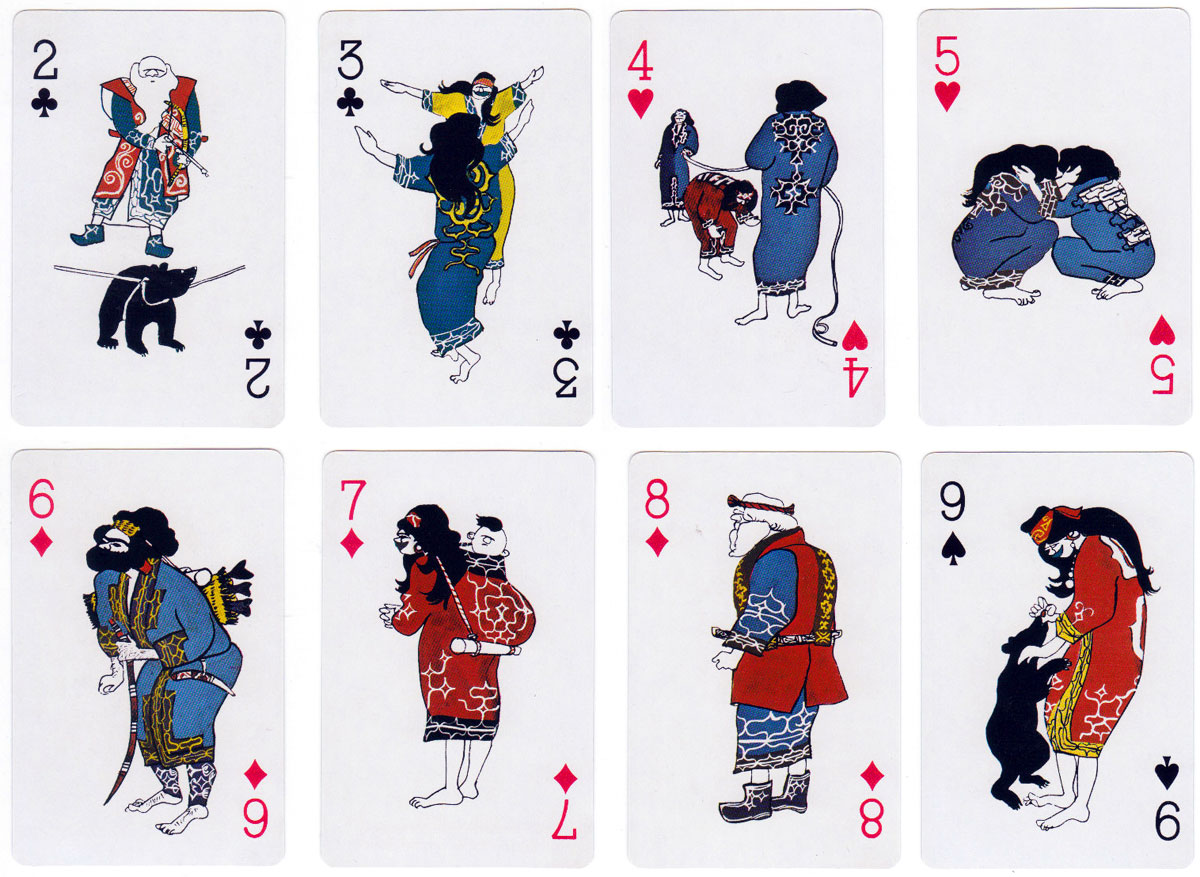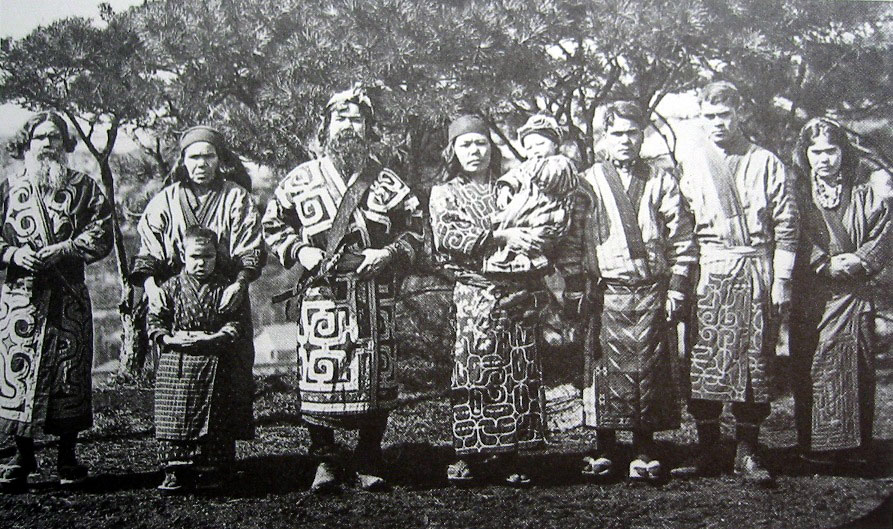Ainu culture
A terrific deck of cards made by Nintendo c.1979 with original designs on every card showing the Ainu, the indigenous people of Japan.
The Ainu are an indigenous people of Japan. Traditional Ainu culture was quite different from Japanese culture, with roots stretching back more than 10,000 years. It is still alive and vibrant today. The Ainu are traditionally animists, believing that everything in nature has a kamuy (spirit or god) on the inside. Never shaving after a certain age, the men had full beards and moustaches Wikipedia →


Above: Ainu playing cards by Nintendo, 1979. 52 cards + 2 jokers. There are two different decks of Ainu cards; this deck is sometimes referred to as "Ainu I" to distinguish it from the second deck, sometimes referred to as "Ainu II." The court card designs are different in the two decks. Images courtesy Rex Pitts.

Above: a group of Ainu people.

By Rex Pitts (1940-2021)
Member since January 30, 2009
Rex's main interest was in card games, because, he said, they were cheap and easy to get hold of in his early days of collecting. He is well known for his extensive knowledge of Pepys games and his book is on the bookshelves of many.
His other interest was non-standard playing cards. He also had collections of sheet music, music CDs, models of London buses, London Transport timetables and maps and other objects that intrigued him.
Rex had a chequered career at school. He was expelled twice, on one occasion for smoking! Despite this he trained as a radio engineer and worked for the BBC in the World Service.
Later he moved into sales and worked for a firm that made all kinds of packaging, a job he enjoyed until his retirement. He became an expert on boxes and would always investigate those that held his cards. He could always recognize a box made for Pepys, which were the same as those of Alf Cooke’s Universal Playing Card Company, who printed the card games. This interest changed into an ability to make and mend boxes, which he did with great dexterity. He loved this kind of handicraft work.
His dexterity of hand and eye soon led to his making card games of his own design. He spent hours and hours carefully cutting them out and colouring them by hand.
Related Articles

Aónikenk playing cards
Ethnographic playing cards made by members of the Aónikenk culture from Patagonia.

ViVa Bourg
A distinctive deck of cards for a specific promotion.

Sumo Wrestling
Traditional Japanese Sumo Wrestling playing cards with photograph of different wrestler on each card...

Dancing
“Dancing” playing cards manufactured by Nintendo for Torii Dance School, Osaka.

Tactics Design
Late modernist Japanese playing cards designed by Masayoshi Nakajo for Tactics Design.

Dragon Quest
Card game based on the Japanese video game series with character illustrations by Akira Toriyama

Morinaga Hakuho playing cards
Artistic playing cards attributed to Morinaga Hakuho and printed by Nintendo, c.1985.

Shin-Tōmei Expressway Opening Commemoration
Promotional playing cards for the Shin-Tōmei Expressway, a major Japanese expressway that opened in ...

Hana-Trump トランプ
Hana-Trump cards from Japan are Hana-Fuda flower cards with miniature international playing cards in...

Mahjong-Trump playing cards
Mahjong tiles integrated with international playing cards.

Japanese Beauties
An elegant fusion of Western and Japanese traditions modelled after ukiyo-e.

Sunday Night / Nichiyoubi no Yoru
An irreverent, avant-garde deck unofficially titled "Nichiyoubi no Yoru" (Sunday Night), designed by...

Angel 52 Secrets
Vintage “52 Secret” art deco-inspired playing cards from Japan.

Banjo Cards
Images of the peg heads from 4-string banjos from Akira Tsumura’s renowned collection.

Mexican ethnic playing cards
Mexican ethnic groups depicted on playing cards by Fábrica de Naipes Cuauhtemoc.

Eki karuta
Japanese fortune-telling cards based on I Ching, with bold, modern designs.
Most Popular
Our top articles from the past 28 days





